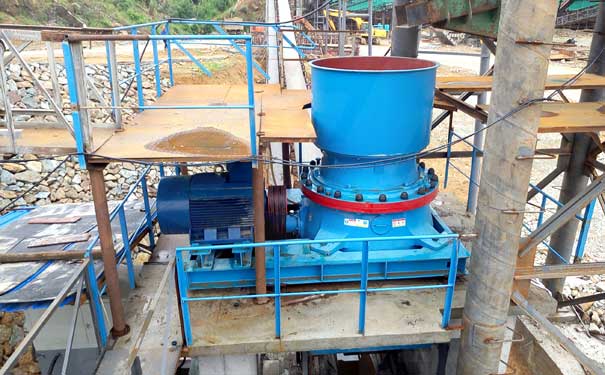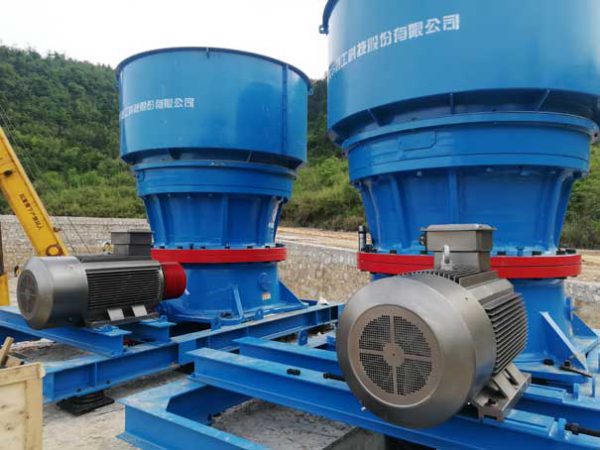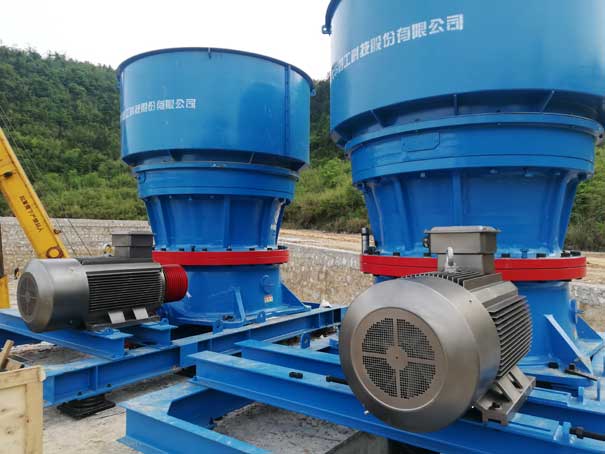The general environment of the crushing site is harsh and dusty. If the belt operator is not in place, the permanent magnet separator does not remove iron very well, the crushing cavity is often over-iron during crushing, and the packing strength is insufficient when the movable cone liner is installed. The cutting ring is not welded firmly, the locking screw is not fastened in place, and the liner is installed improperly, which will cause the movable cone liner to be easily broken during use.
During the crushing process of the cone crusher, the fixed cone lining plate and the fixed cone body are fixed, and the moving cone lining plate and the moving cone body have slow rotating motion because the eccentric sleeve has an eccentric distance and a transverse stroke along with the eccentric sleeve. Movement, the bulky materials are broken during the rotation and lateral stroke movement of the moving cone, so the moving cone liner wears faster.

Analysis of Failure Causes of Moving Cone Lining Plate
In the process of crushing materials by the cone crusher, the moving cone liner does both slow rotating motion and lateral stroke motion at the same time. The crushing load acting on the liner is relatively large, including both circumferential load and radial load. Therefore, when the following defects exist in the installation or crushing process of the lining board, it is easy to cause the rupture and failure of the movable cone lining board.
(1) The lining board is not leveled and adjusted when it is installed, and it is tilted to one side. When the lining board is broken, the load is uneven and it is easy to break and fail.
(2) When the liner is installed, the filler composition is not fully mixed and evenly mixed, the filling strength is low, and the liner is easy to break and fail when broken.
(3) The filler solidification time is not enough when the liner is installed. Generally, about 16 hours is required. If the solidification time does not reach the specified time, the filler has not completely solidified, and the strength is low.
(4) When the liner is installed, the locking screw is not fastened in place, and the tightening strength is not enough. The liner is loose and easy to rupture during the crushing process.
(5) When the liner is installed, the compression and cutting ring above is not welded firmly, or the welding seam is worn out during the crushing process, and the liner is loose and easy to break and fail.
(6) In the crushing process, the crushing cavity often enters the iron block. The hardness of the iron block is relatively large, and the crushing load changes drastically. When the rated crushing load of the liner is exceeded, the liner is easy to rupture and fail.

Preventive Measures against Liner Cracks
According to the above analysis, the main reason for the failure of the moving cone liner is that the installation defect causes the liner to break in a short time during the crushing process, or the crushing cavity often enters the iron block during the crushing process, which causes the liner to break. Therefore, take the following corresponding measures based on the defects listed in the above analysis.
(1) When the lining board is installed, it is leveled and adjusted, so that the load around the lining board is evenly balanced during crushing.
(2) When the liner is installed, the filler components are fully mixed and stirred evenly, so that the strength of the filling and solidification is higher.
(3) The solidification time of the filler during the installation of the lining board is generally required to be about 16 hours, so that the filler is completely solidified and sufficient strength can be ensured to be broken;
(4) When the liner is installed, the locking screw is fastened in place, and the fastening strength is sufficient, and the liner is not easy to loosen during the crushing process.
(5) When the lining plate is installed, the upper compression cutting ring and the lining plate are welded firmly. During the crushing process, check whether the weld seam is open or not, and if it is open, re-weld firmly.
(6) In order to prevent iron blocks from entering the crushing cavity frequently during the crushing process, a reasonable iron remover is installed at the head of the feed belt to remove the iron blocks that enter the crushing cavity, so that the liner is balanced and evenly during the crushing process.
Install the liner reasonably; install the iron remover on the head of the feed belt conveyor to ensure that the load around the moving cone liner is even. The operator regularly checks and carefully observes the operation of the equipment, optimizes all aspects of performance, improves the production efficiency of the cone crusher, and reduces production cost.

